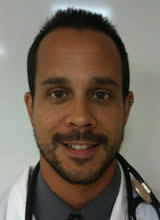
Gladimir is only 28 years old, and he’d be dead in any other hospital in Haiti. Of course, he doesn’t know that because he’s been unconscious since he fell off of a motorcycle three days ago.
His family understands how seriously ill he is, and they come to help the nurses clean him and periodically turn his body to prevent bed sores. They’ve never seen a ventilator before, but they can see his chest rise and fall with each breath the machine gives him. They probably don’t understand why he has tubes under both ribs, but they can see the bloody fluid that the tubes suck out of his body, allowing his lungs to expand fully in his chest.
Project Medishare Hospital has the only intensive care unit in Haiti that has ventilators and also medications called vasopressors that support the blood pressure in critically ill patients. The nurses who care for him are the only Haitian nurses who know how to operate ventilators and titrate vasopressors up and down depending on the blood pressure readings. They know how to clean and suction the tube in his throat to prevent it from clogging. I try to teach them to elevate the head of the bed of another patient to minimize the chances of pneumonia from oral secretions that drain into the lungs. “Yes, doctor, we know. His bed is down only so we can change the sheets and then we’ll put him back up.” Truly amazing that in such a short period of time, nurses who had previously never seen a ventilator outside of an operating room are now experts in caring for critically ill patients.
Gladimir’s face is unrecognizable, swollen from bearing the brunt of the force of being tossed off of the bike. Virtually every bone in his face is broken, including his jaw, and the swelling would have made it impossible to breathe on his own without the tube down his throat keeping the airway open. The trauma also tore open his trachea and punctured both of his lungs. With each breath he took after the accident, the air entered and then escaped through the holes into his chest cavity, around his lungs, progressively compressing them until no more air could actually fill the lungs.
The emergency room doctor placed two large plastic tubes under his ribs to suck the air out and re-inflate the lungs. The process left Gladimir with massive amounts of air in his skin and between layers of muscle, distorting the shape of his chest and neck, making him look like an overinflated balloon. Now, gently pressing on the skin of the torso and neck, I can feel the air as it squishes under his tissues, like snapping the small air pockets of bubble wrap. The ventilator and stress of his condition causes a stomach ulcer that bleeds, causing a severe anemia and necessitating blood transfusions.
The group of doctors caring for him begins discussing his chances for survival, and if the resources required to maintain him would be better spent elsewhere, allowing him to die. He would be dead anywhere else in Haiti already. It’s an argument I used to make out of ignorance.
As a primary care physician, I initially scoffed at the idea of a trauma and critical care hospital in Port-au-Prince. Critical care is expensive and the money could save many lives if spent on primary care, I said. Then I saw countless cases like Gladimir — young, healthy people stricken by a car accident or a stray bullet who would have otherwise died; an asthmatic who needs to be on a ventilator for 12 hours ;a middle aged woman with pneumonia or tuberculosis who requires ventilation for a few days while antibiotics have time to attack the infection. With HIV/AIDS treatment widely available, trauma is now the leading cause of disability and death in young adults in developing countries. Not only does critical care in this setting save lives, but it ensures that the most economically-productive age group in the country is not taken from their families. The fact that critical care is expensive is not a viable excuse to not provide it; in fact, from a societal perspective, it is a cost-effective intervention to save the young and get them back to work.
Over the course of 10 days, Gladimir’s condition improves significantly. His jaw is wired shut and the bones in his face are supported with internal metal plates, expertly placed by a Haitian surgeon. To accomplish the operations, the breathing tube is moved to a surgically-created hole in his trachea, also making it possible to wake him up. His lungs heal the puncture wounds and cease to spill air in his chest cavity, and the tubes in his chest are pulled out one at a time. The sensation of crunching Rice Krispies under his skin has decreased, and the remainder will harmlessly reabsorb over time. He starts eating for the first time in two weeks, slurping up protein shakes and pureed beans and rice through a straw. I can make out distinct features in his face, the visage that he had before the accident finally peeking out.
We place him in a wheelchair so he can stay mobile despite his broken leg, and he spends the last two days in the hospital outside the ICU, talking to other patients’ families. The tracheostomy tube in his throat is finally removed, and I hear Gladimir’s voice for the first time. I can only make out a few words, poorly formed because he cannot move his jaw and his mouth is full of wires.
“I’d like to go home,” he says, learning how to talk by moving only his lips.
“Nothing would make me happier,” I reply.
Vincent DeGennaro is an internal medicine doctor and a global public health specialist at the University of Miami’s Department of Medicine and works part time in Haiti with the nonprofit Project Medishare. See his An American Doctor in Haiti blogs.